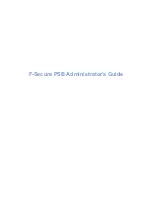
550
Chapter 25: Using Verity Search Expressions
The following example uses a proximity operator:
<cfsearch name = "quick_search"
collection="bbb"
type = "explicit"
criteria="red<near>socks">
For an example using the IN proximity operator to search XML documents , see
“Zone searches”
on page 552
.
Score operators
Score operators control how the search engine calculates scores for retrieved documents. The
maximum score that a returned search element can have is 1.000. You can set the score to display
a maximum of four decimal places.
When you use a score operator, the search engine first calculates a separate score for each search
element found in a document, and then performs a mathematical operation on the individual
element scores to arrive at the final score for each document.
The document’s score is available as a result column. You can use the SCORE result column to
get the relevancy score of any document retrieved; for example:
<cfoutput>
<a href="#Search1.URL#">#Search1.Title#</a><br>
Document Score=#Search1.SCORE#<BR>
</cfoutput>
The following table describes the score operators:
Operator
Description
Example
YESNO
Forces the score of an element to 1 if the
element’s score is nonzero.
<YESNO>mainframe
. If the retrieval
result of the search on mainframe is
0.75, the YESNO operator forces
the result to 1. You can use YESNO
to avoid relevance ranking.
PRODUCT
Multiplies the scores for the search
elements in each document matching a
query.
<PRODUCT>(computers, laptops)
takes the product of the resulting
scores.
SUM
Adds the scores for the search element in
each document matching a query, up to a
maximum value of 1.
<SUM>(computers, laptops)
takes
the sum of the resulting scores.
COMPLEMENT
Calculates scores for documents matching
a query by taking the complement
(subtracting from 1) of the scores for the
query’s search elements. The new score is 1
minus the search element’s original score.
<COMPLEMENT>computers
. If the
search element’s original score is
.785, the COMPLEMENT
operator recalculates the score as
.215.
Summary of Contents for COLDFUSION MX 61-DEVELOPING COLDFUSION MX
Page 1: ...Developing ColdFusion MX Applications...
Page 22: ...22 Contents...
Page 38: ......
Page 52: ...52 Chapter 2 Elements of CFML...
Page 162: ......
Page 218: ...218 Chapter 10 Writing and Calling User Defined Functions...
Page 250: ...250 Chapter 11 Building and Using ColdFusion Components...
Page 264: ...264 Chapter 12 Building Custom CFXAPI Tags...
Page 266: ......
Page 314: ...314 Chapter 14 Handling Errors...
Page 344: ...344 Chapter 15 Using Persistent Data and Locking...
Page 349: ...About user security 349...
Page 357: ...Security scenarios 357...
Page 370: ...370 Chapter 16 Securing Applications...
Page 388: ...388 Chapter 17 Developing Globalized Applications...
Page 408: ...408 Chapter 18 Debugging and Troubleshooting Applications...
Page 410: ......
Page 426: ...426 Chapter 19 Introduction to Databases and SQL...
Page 476: ...476 Chapter 22 Using Query of Queries...
Page 534: ...534 Chapter 24 Building a Search Interface...
Page 556: ...556 Chapter 25 Using Verity Search Expressions...
Page 558: ......
Page 582: ...582 Chapter 26 Retrieving and Formatting Data...
Page 668: ......
Page 734: ...734 Chapter 32 Using Web Services...
Page 760: ...760 Chapter 33 Integrating J2EE and Java Elements in CFML Applications...
Page 786: ...786 Chapter 34 Integrating COM and CORBA Objects in CFML Applications...
Page 788: ......
















































